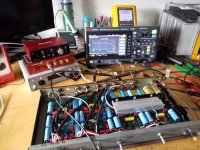I use a dash mount, suction cup, spring loaded adjustable clamps.
Safer than windscreen, the heat in a closed car can go to 70 degrees if it is left in the sun at 45 degrees C.
That means most suction cups will fail over time.
Safer than windscreen, the heat in a closed car can go to 70 degrees if it is left in the sun at 45 degrees C.
That means most suction cups will fail over time.
A guy approached me asking to fix his late 80s preamp, he bought it used with no clue to its function, power supply was missing, so I build a new one, external with xlr connector.
Relays didn't click either, and some resistors near power regulators were blackened, it ran very high class a on output, so I reduced it a bit.
Capacitors should have been changed, but it would take huge amounts of time, finding axial ones and replace them all, it performed nicely, so the guy left it as is..
Relays didn't click either, and some resistors near power regulators were blackened, it ran very high class a on output, so I reduced it a bit.
Capacitors should have been changed, but it would take huge amounts of time, finding axial ones and replace them all, it performed nicely, so the guy left it as is..
Attachments
I guess fixing old pots of my friends amplifiers is my new hobby.. A friend of mine loves his old Philips AH684 receiver / amplifier, but had nasty crackling pots and switches.. I wanted to discard the volume control for a new one, but it has a special section for the loudness function to work properly.. So I cleaned it and snipped away the worn parts of the poti brushes.. Surprisingly it works very smooth now, looking at the worn carbon tracks I did not anticipate this..

The Input selector switch looked extra nasty.. It doesn't only switch input signals but also the supply voltages for the AM / FM Radio part. Maybe that's why the contacts looked so burned?

After reassembling the tone control board and input selector I realised that there was a unwanted DC voltage on the right input channel. It took a while to realise that it came from the radio PCB through the input selector. I wasn't smart enough to figure out why the radio part injected the DC voltage. But my friend doesn't use the radio part of the amplifier, so I just disconnected the supply rails of the radio PCB and the DC voltage went away.
I also checked the fourty years old PSU filter caps and they measured perfect, so I left them alone. To my surprise the loudspeaker relais still works like a charm.. After that I replaced the defective light bulbs with some warm white LEDs. Now I hope that my friend can enjoy his old amp for some more years..

Maybe someone of you can help me with my last question regarding this project: Philips AH684 - bias adjustment - can't find the test points..
The Input selector switch looked extra nasty.. It doesn't only switch input signals but also the supply voltages for the AM / FM Radio part. Maybe that's why the contacts looked so burned?
After reassembling the tone control board and input selector I realised that there was a unwanted DC voltage on the right input channel. It took a while to realise that it came from the radio PCB through the input selector. I wasn't smart enough to figure out why the radio part injected the DC voltage. But my friend doesn't use the radio part of the amplifier, so I just disconnected the supply rails of the radio PCB and the DC voltage went away.
I also checked the fourty years old PSU filter caps and they measured perfect, so I left them alone. To my surprise the loudspeaker relais still works like a charm.. After that I replaced the defective light bulbs with some warm white LEDs. Now I hope that my friend can enjoy his old amp for some more years..
Maybe someone of you can help me with my last question regarding this project: Philips AH684 - bias adjustment - can't find the test points..
Aside from building myself new RCA interconnects of minimum length to clean up the mess this weekend, last thing I worked on was a Technics SA-202 I ended up putting into a mini system as a gift for some friends. Lots of leaky caps got replaced, new lamps, thorough cleaning and all is well again. Paired it a pair of Infinity RS10 book shelf speakers and an AT LP60 turntable for them. Their previous set up was a Crosley suitcase turntable. The fully automatic TT was a specific requirement as my friend has CP affecting her hands mostly, so she was unable to play records on her own without damaging the stylus or record. She now can play them just fine.
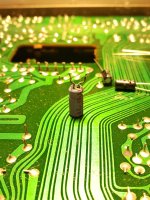
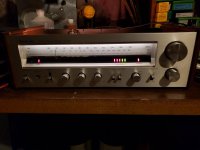


Today, after almost 4 years of 24/7 operation, the 3$ 12V500mA SMPS that powers my Nixie clock and touch power relay board called it quits while I was in the shower.
Turned on for ~5 seconds, died, lather, rinse, repeat.
I considered repairing it, but I don't have the caps that are probably bad, and they would cost more than a new one anyway.
Swapped it and all is working again.
Found a bluetooth board had decided not to work anymore, so I removed it while I get a replacement (low priority)
Swapped out an analog to digital converter in my preamp - apparently, it's the only solid state device I have that becomes damaged from the turn on voltages in the preamp (with no load at all it'll peak 70V on start up for a moment, and even though the device was transformer coupled, they still passed the spike. Installed the replacement but added some P6KE13CA bidirectional TVS to clamp the output on start.
It's nice to have the amplifiers on the wall fed by optical again, even though I already eliminated the ground loop I had that prompted me to use optical in the first place (plugged all the amps on the wall onto the same circuit as the rest of the system through an extension cord).
I'm amazed I got a system with 8 stereo amps, 2 monoblocs, turntable, tape, minidisc, cd, tuner, eq, computer through DAC and ADC, Bluetooth, 2 speaker switches, television on a second DAC, and an active crossover to have no hum! It took a long time but good results 🙂
Turned on for ~5 seconds, died, lather, rinse, repeat.
I considered repairing it, but I don't have the caps that are probably bad, and they would cost more than a new one anyway.
Swapped it and all is working again.
Found a bluetooth board had decided not to work anymore, so I removed it while I get a replacement (low priority)
Swapped out an analog to digital converter in my preamp - apparently, it's the only solid state device I have that becomes damaged from the turn on voltages in the preamp (with no load at all it'll peak 70V on start up for a moment, and even though the device was transformer coupled, they still passed the spike. Installed the replacement but added some P6KE13CA bidirectional TVS to clamp the output on start.
It's nice to have the amplifiers on the wall fed by optical again, even though I already eliminated the ground loop I had that prompted me to use optical in the first place (plugged all the amps on the wall onto the same circuit as the rest of the system through an extension cord).
I'm amazed I got a system with 8 stereo amps, 2 monoblocs, turntable, tape, minidisc, cd, tuner, eq, computer through DAC and ADC, Bluetooth, 2 speaker switches, television on a second DAC, and an active crossover to have no hum! It took a long time but good results 🙂
We have actively avoided samsung. The only samsung device is an aging LCD tv (that has a buzz due to the backlight design during dark scenes).Ugh!
More Samsung crap?
That company's products are junk, dangerous, and have class-action lawsuits by the dozens.
Lots of angry customers.
I wish that company would fold and go bankrupt.
Phone batteries.. etc etc and the repeated bad PR are the reason for my avoidance.
If you ignore the CDP, painting, etc then I think the next repair is the garden path 🙂
@NickKUK
Indeed, avoid that brand at all costs.
Asides what I've managed to research online, I've also got decades of experience with Samsung products that came into my repair shop.
And once you've seen what those products have amounted to (cost cutting, design flaws, etc) you become biased like I have.
Back in 2005, I purchased a Samsung 30" -Slimfit- widescreen CRT set which costed me $1000.
I liked the cabinet style, it had all the features that I was looking for, and in the showroom I thought the picture quality was fine.
However, afterwards in my home, I took notice of a "bowing" of the picture. - the bottom of the screen seemed to bow upwards, most noticeably when those bottom "banners" would be broadcast.
That, to me, for the price, was not acceptable.
It was a design flaw, not adjustable, the CRT deflection yoke was poorly designed for "widescreen" operation.
I lived with it. - I was not about to lug a 120 pound set back to the store, it takes 2 people to maneuver it.
And being in the service industry, none of my colleagues knew of an answer either.
Also, running a service shop and dealing with Samsung's Service Department for tech support for issues with customer's products, was always a maddening experience - they acted contrary, snotty, and at times refused to answer simple questions.
They treated me like a dumb idiot consumer even though they knew I was a professional service tech.
My answer to them was "Well, I'll be sure to pass your attitude on to my customer, and surely they'll purchase another brand next time they go shopping".
Over here in the USA, there's all sorts of complaints - washing machines literally exploding and ripping through laundry room walls, a new complaint is washing machines catching fire and damaging homes.
And there are others.. leading to class-action lawsuits.
But the company is so big, they get around issues tossed at them.
Not a good way to build a reputation.
Indeed, avoid that brand at all costs.
Asides what I've managed to research online, I've also got decades of experience with Samsung products that came into my repair shop.
And once you've seen what those products have amounted to (cost cutting, design flaws, etc) you become biased like I have.
Back in 2005, I purchased a Samsung 30" -Slimfit- widescreen CRT set which costed me $1000.
I liked the cabinet style, it had all the features that I was looking for, and in the showroom I thought the picture quality was fine.
However, afterwards in my home, I took notice of a "bowing" of the picture. - the bottom of the screen seemed to bow upwards, most noticeably when those bottom "banners" would be broadcast.
That, to me, for the price, was not acceptable.
It was a design flaw, not adjustable, the CRT deflection yoke was poorly designed for "widescreen" operation.
I lived with it. - I was not about to lug a 120 pound set back to the store, it takes 2 people to maneuver it.
And being in the service industry, none of my colleagues knew of an answer either.
Also, running a service shop and dealing with Samsung's Service Department for tech support for issues with customer's products, was always a maddening experience - they acted contrary, snotty, and at times refused to answer simple questions.
They treated me like a dumb idiot consumer even though they knew I was a professional service tech.
My answer to them was "Well, I'll be sure to pass your attitude on to my customer, and surely they'll purchase another brand next time they go shopping".
Over here in the USA, there's all sorts of complaints - washing machines literally exploding and ripping through laundry room walls, a new complaint is washing machines catching fire and damaging homes.
And there are others.. leading to class-action lawsuits.
But the company is so big, they get around issues tossed at them.
Not a good way to build a reputation.
I have some Samsung products that are fine, and I've had other stuff that was infuriating.
My 32" 4k computer monitor had a good picture, and has lasted longer than the Asus it replaced (4k monitor, one section of backlight went out, easiest fix would have been to disassemble the monitor, build a box/frame for it, and light it with a damn lamp... Since I didn't want to turn my monitor into a Lite-Brite, I trashed it). Been running for over 3 years so far without issue. The Asus lasted about 2 years.
Formerly I had an HP monitor with 4 year on-site warranty. They had to come and replace it FOUR TIMES in three years - then I sold it.
My 85" 4k Samsung TV was the cheapest thing I could find that was 85" and not complete garbage. It's been running 24/7 for over 2 years now. If I get 5 years out of it, I'll be happy - My next television WILL be a Sony - the interface is slow and annoying to use on the Samsung, and you can't turn off screen dimming so the brightness dips when there's not much on the screen. You can turn it off on higher models though. The service menu is your friend though - it doesn't dim the damned screen now!
I've had several Samsung phones - most with the S-pen but my latest experience with the Fold 3 made me swear not to buy another Samsung again. Not only did it break, it ANGERED me to the point that this is what it looked like when I finished with it, but before I threw it away (and I'm still paying for the effing thing):
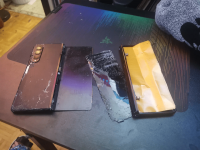
I'm now using a Google Pixel, rooted with a custom ROM but still passes CTS, Play Protect, and SafetyNet.
I generally find Samsung makes flashier stuff with more features for the money but they die after 4 or 5 years but meanwhile I have a Sony Bravia I found out to the curb from 2009 that works perfectly, and has a beautiful picture - I guess they got a new one.
I don't like LG (lucky GoldStar), Hyundai ( We Make Crap!™) or Kia (Welfare Hyundai) either. I have far better success and experiences with Chinese products from companies you've never heard of (like the CalmDo air fryer oven that replaced by Breville. 1/3 the price, and it's already outlived it) than anything I've ever bought from a Korean corporation...
My 32" 4k computer monitor had a good picture, and has lasted longer than the Asus it replaced (4k monitor, one section of backlight went out, easiest fix would have been to disassemble the monitor, build a box/frame for it, and light it with a damn lamp... Since I didn't want to turn my monitor into a Lite-Brite, I trashed it). Been running for over 3 years so far without issue. The Asus lasted about 2 years.
Formerly I had an HP monitor with 4 year on-site warranty. They had to come and replace it FOUR TIMES in three years - then I sold it.
My 85" 4k Samsung TV was the cheapest thing I could find that was 85" and not complete garbage. It's been running 24/7 for over 2 years now. If I get 5 years out of it, I'll be happy - My next television WILL be a Sony - the interface is slow and annoying to use on the Samsung, and you can't turn off screen dimming so the brightness dips when there's not much on the screen. You can turn it off on higher models though. The service menu is your friend though - it doesn't dim the damned screen now!
I've had several Samsung phones - most with the S-pen but my latest experience with the Fold 3 made me swear not to buy another Samsung again. Not only did it break, it ANGERED me to the point that this is what it looked like when I finished with it, but before I threw it away (and I'm still paying for the effing thing):

I'm now using a Google Pixel, rooted with a custom ROM but still passes CTS, Play Protect, and SafetyNet.
I generally find Samsung makes flashier stuff with more features for the money but they die after 4 or 5 years but meanwhile I have a Sony Bravia I found out to the curb from 2009 that works perfectly, and has a beautiful picture - I guess they got a new one.
I don't like LG (lucky GoldStar), Hyundai ( We Make Crap!™) or Kia (Welfare Hyundai) either. I have far better success and experiences with Chinese products from companies you've never heard of (like the CalmDo air fryer oven that replaced by Breville. 1/3 the price, and it's already outlived it) than anything I've ever bought from a Korean corporation...
So that little SMPS I posted about - I ended up finding caps that I could fit... The original 6.8µF/400V is now 10µF/450V, and the two 470µF/25V caps are now 1500µF/16V. And it works again 🙂 but only after I installed the first 10µ cap backwards and watched it vent when I plugged it in lol
I didn't change C3
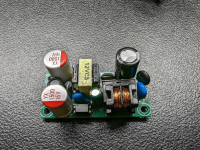
I didn't change C3

I "repaired" a garage door lift, by taking it apart and putting it back together again, well the power supply / logic PCB anyway. Intermittent operation - the whole thing would suddenly go dead in the middle of opening / closing. Light out on the button, courtesy light out.
Got the ladder, took the end cap with the board down, powered it up with AC on the bench, measured some voltages - all fine. Nothing observable, except some dust particles which I brushed off the solder side. Hmmmmm... Put it all back together and it works; we'll see if it remains that way.
Meanwhile...Wife encouraged me to go get a lift advertised in a free pile a couple miles away, so I did. Needed tools to get it in the car because of the long rail having to come apart / off, so home and back again... Figured we'd swap the power supply in that one for this one. Completely different design...having separate PSU board. Thing was in great condition, came with button / safety sensors, so I connected it all up, verified operation, now I have a spare.
Got the ladder, took the end cap with the board down, powered it up with AC on the bench, measured some voltages - all fine. Nothing observable, except some dust particles which I brushed off the solder side. Hmmmmm... Put it all back together and it works; we'll see if it remains that way.
Meanwhile...Wife encouraged me to go get a lift advertised in a free pile a couple miles away, so I did. Needed tools to get it in the car because of the long rail having to come apart / off, so home and back again... Figured we'd swap the power supply in that one for this one. Completely different design...having separate PSU board. Thing was in great condition, came with button / safety sensors, so I connected it all up, verified operation, now I have a spare.
Years ago I had a garage opener problem exactly as you describe. Problem was the plastic connector that snapped into it to make the connection to the 2 external wires for operation; connection would be intermittent from the vibrations during operation. Snipping the connector off and soldering the wires directly to the pins solved the problem.
I'd go over the circuit board with a magnifier to look for "ring joints" which cannot be detected with a casual look.I "repaired" a garage door lift, by taking it apart and putting it back together again, well the power supply / logic PCB anyway. Intermittent operation - the whole thing would suddenly go dead in the middle of opening / closing. Light out on the button, courtesy light out.
Got the ladder, took the end cap with the board down, powered it up with AC on the bench, measured some voltages - all fine. Nothing observable, except some dust particles which I brushed off the solder side. Hmmmmm... Put it all back together and it works; we'll see if it remains that way.
That's what helped keep me in business for decades in the shop.
Relays, heatsinked components, power resistors, among other things are prone to loosening up due to thermal cycling, and vibrations.
Drydock Eureka, trying to keep it afloat until the sale goes through, a shipyard in turkey is interested in both #2and eureka.
A friend of mine asked me to check the power supply unit of his Tascam M-3700 Studio mixing console. The PSU provides multiple voltages to the console, +/-15V for all the OpAmps, +48V for the mic phantom power and +5V, +8V, +12V for different purposes like VU meter background lights and so on.
The +/-15V channel was not working and initially I thought that the M5230 voltage regulator IC might have failed.
I spent a lot of time measuring voltages and trying to understand what failed. I checked the power transistors and the bridge rectifier. After I looked at the PCB from the solder side I realised there was a bad solder joint on one of the pins of the connector where the bridge rectifier plugs in.

After inspecting the connector I think that the contact surface is way too small by design and 20 years of use and oxidation lead to this failure. If it was my device I would get rid of all the connectors and solder all the cables directly to the PCB.
After cleaning and applying fresh solder the +/- 15V channel of the PSU worked again.
The +/-15V channel was not working and initially I thought that the M5230 voltage regulator IC might have failed.
I spent a lot of time measuring voltages and trying to understand what failed. I checked the power transistors and the bridge rectifier. After I looked at the PCB from the solder side I realised there was a bad solder joint on one of the pins of the connector where the bridge rectifier plugs in.
After inspecting the connector I think that the contact surface is way too small by design and 20 years of use and oxidation lead to this failure. If it was my device I would get rid of all the connectors and solder all the cables directly to the PCB.
After cleaning and applying fresh solder the +/- 15V channel of the PSU worked again.
Perhaps that's what WOT was suggesting to look for, a couple posts up.
Oh yeah, I did not see the above posts. As a mechanic i am surprised to realise how many failures in electronic devices have their root cause in mechanical failures like solder joints, bad connectors or crimping, dirty switches or pots and so on..
Yepper!Perhaps that's what WOT was suggesting to look for, a couple posts up.
While in modern times, "wave soldering" of PC boards is the current way to build things, it's also a weak-spot of design.
Strict Quality Control is mandatory in such cases, however, it cannot foresee use-related issues down the road.
And that thin layer of soldering will eventually raise its ugly head.
In "the old days", hand soldering of PC boards, along with point-to-point wiring, rarely caused failures.
And it gave someone a (tedious) job in the factory, instead of some machine doing the work.
Here's a 1961 pocket transistor radio - bounced around, knocked around, carried around, for 61 years, and still playing great, just needing some old capacitors replaced.
- Home
- Member Areas
- The Lounge
- What did you last repair?
